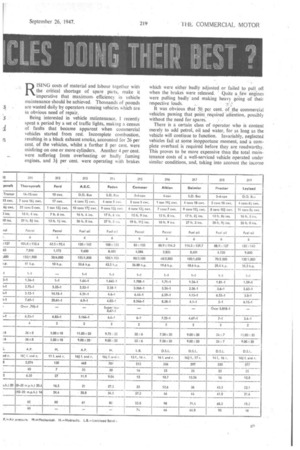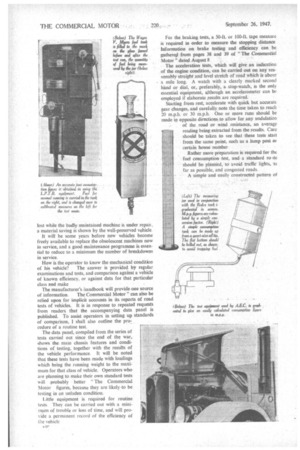ICLES 10111G
Page 43

Page 44

Page 47

If you've noticed an error in this article please click here to report it so we can fix it.
B11111 EUST
RISING costs of material and labour together with the critical shortage of spare parts, make it imperative that maximum. efficiency in vehicle maintenance should be achieved. Thousands of pounds are wasted daily by operators running vehicles which are in obvious need of repair.
Being interested in vehicle ingintenance, I recently spent a period by a set of traffic lights, making a census of faults that became apparent when commercial vehicles started from rest. Incomplete combustion, resulting in a black exhaust smoke, accounted for 26 per cent. of the vehicles, whilst a further 8 per cent. were misfiring on one or more cylinders. Another 4 per cent. were suffering from overheating or badly fuming engines, and 3i per cent. were operating with brakes which were either badly adjusted or failed to pull, oft when the brakes were released. Quite a . few engines were pulling badly and making heavy going of their respective loads.
It was obvious that 50, per cent, of the commercial vehicles passing that point, required 'attention, possibly without the need for spares.
There is a certain class of operator who is content merely to add petrol, oil and water, for as long as the vehicle will continue to function. Invariably, neglected vehicles fail at Some inopportune moment, and a complete overhaul is required before they are roadworthy. This proves to be more expensive than the total maintenance costs of a well-serviced vehicle operated under similar conditions, and, taking into account the income lost while the badly maintained machine is under repaii, a material saving is shown by the well-preserved vehicle.
It will be some years before new vehicles become freely available to replace the obsolescent machines now in service, and a good maintenance programme is essential to reduce to a minimum the number of breakdowns in service.
How is the operator to know the mechanical condition of his vehicle? The answer is provided by regular examinations and tests, and comparison against a vehicle of known efficiency. or against data for that particular class and make
The manufacturer's handbook will provide one source of information. The Commercial Motor can also be relied upon for implicit accounts in its. reports of road tests of vehicles. It is in response to repeated requests from readers that the accompanying data panel is published. To assist operators in setting up standards of comparison, I shall also outline the procedure of a routine test.
The data panel, compiled from the series of tests carried out since the end of the war, shows the main chassis features and conditions of testing, together with the results of the vehicle performance. It will be noted that these tests have been made with loadings which bring the running weight to the maximum for that class of vehicle. Operators who are planning to make their own standard tests will .probably better "The Commercial Motor figures, because they are likely-to be testing in an unladen condition.
Little equipment is required for routine tests. They can be carried out with a minimum of trouble or loss of time, and will provide a permanent record of the efficiency of the veh icic
U if' For the braking tests, a 504t. or 100-ft tape measure is required in order to measure the stopping distance information on brake testing and efficiency can be gathereit from pages 38 and 39 of "The Commercial Motor " dated August 8
The acceleration tests, which will give an indication of the engine condition, can be carried out on any reasonably straight and level stretch of road which is abouta mile long. A watch with a clearly marked second hand or dial, or, preferably, a stop-watch, is the only essential equipment, although an accelerometer can be employed if elaborate results are required.
Starting from rest, accelerate with quick but accuratt gear changes, and carefully note the time taken to reach 20 m.p.h. or 30 m.p.h. One or more runs should be made in opposite directions: to allow for any undulation of the road or wind resistance, an average reading being extracted from the results. Care should be taken to see that these tests start from the same point, such as a lamp post or certain house number.
Rather more preparation is required for the fuel consumption test, and a standard ro te should be. planned, to avoid traffic lights, far as possible, and congested roads.
A simple and easily constructed pattern at fuel measure may be fabricated by employing a quart-size oil tin, replacing the fat bottom of the tin with a small funnel. A bracket can be made up to hold the tin rigidly on the dashboard, and the base of the funnel portionconnected to the carburetter or injection pump by means of copper tubing. The object of modifying the base of the tin is to avoid any fuel being trapped in the can, should it not be mounted quite vertically.
The vehicle should be run for a few miles to warm up the engine and other working parts to a normal temperature. If not already running on fuel from the measure, a quick change-over should be made, with the normal fuel supply returning to the tank and the
measures connected in circuit. Ensuring that no air locks are present, the measure should be filled to overflowing, and the cap, with a small air vent pierced in the top, replaced.
With the trip meter on the speedometer set at zero and a note made of the time, the test run should be started. It is preferable that the Same driver should be used for all consumption tests, to ensure that running conditions, such as gear changing and road• speeds. are relatively similar. Note should be taken of the time and distance travelled before the fuel from the measures is exhausted An average running speed can be calculated from the result.
. Comparing Vehicle Performance
Unless the fuel be measured into the test tank, m.p.g. figures for the test will not be produced. but the results will serve as a comparison with other vehicles tested under similar conditions. Subsequent tests of the same vehicle will show any increase in fuel consumption by the vehicle's travelling a shorter distance before the fuel is exhausted.
A record of the acceleration, braking and consumption tests will identify those vehicles requiring first attention to promote economical running. A monthly visual check of axles, steering, suspension and transmission wear will supply the operator with the remainder of the history of the state of his vehicles, so that he may take the desired preventive and remedial measures.
A simple form of fuel-consumption test equipment is manufactured tly Wayne V. Myers Co.. Ltd., Dolben
Street, London, better known, perhaps, as the manufacturer of Redex equipment. This apparatus consists of a rectangular storage tank which has a glass funnelshaped filler, and a measuring jar graduated in ounces The storage tank is connected to the fuel-injection pump or carburetter, and filled to a mark on the glass funnel. The vehicle is then driven a specified distance and the storage tank refilled, using the measuring jar to obtain the result in ounces. By a simple conversion factor, the distance travelled and the quantity used can be converted to tn.p.g.
A More Accurate Test A more intricate apparatus is used by the London Passenger Transport Board in fuel-consumption tests. This equipment was made up nearly 20 years ago by the experimental department, and has given highly satisfac
tory results on all types of consumption test. The equipment, mounted on a board, is secured to the front bulkhead inside the bus. Fuel is pumped from the main tank to a storage tank and the requisite measures fixed to the board.
Fuel from the storage tank is used to run out to the start of the test route, and through a two-way tap the tank is cut out and fuel measures put into circuit. With four stops to a mile, representing service conditions, the test route of 10.37 miles is then traversed. At the end of the test circuit, the fuel left in the measures is tun through to a finely graduated measure, and m.p.g. to three decimal places is subsequently deduced from the results obtained.
A calibrated tank used by the Associated Equipment Co., Ltd., Southall, gives direct measured results, without requiring further use of measuring cylinders, thus enabling tests to be carried out and results secured with a minimum loss of time.
The recording accelerometer, manufactured by Dobbie McInnes, Ltd., Bothwell Street, Glasgow, is arousing interest in the vehicle manufacturers' experimental departments. This instrument, as its name implies, records a graph of the acceleration and braking of a vehicle, and may be used as a seismometer. A comparison of graphs of a particular vehicle taken over a period of time will show any falling-off in performance.




















































































